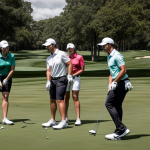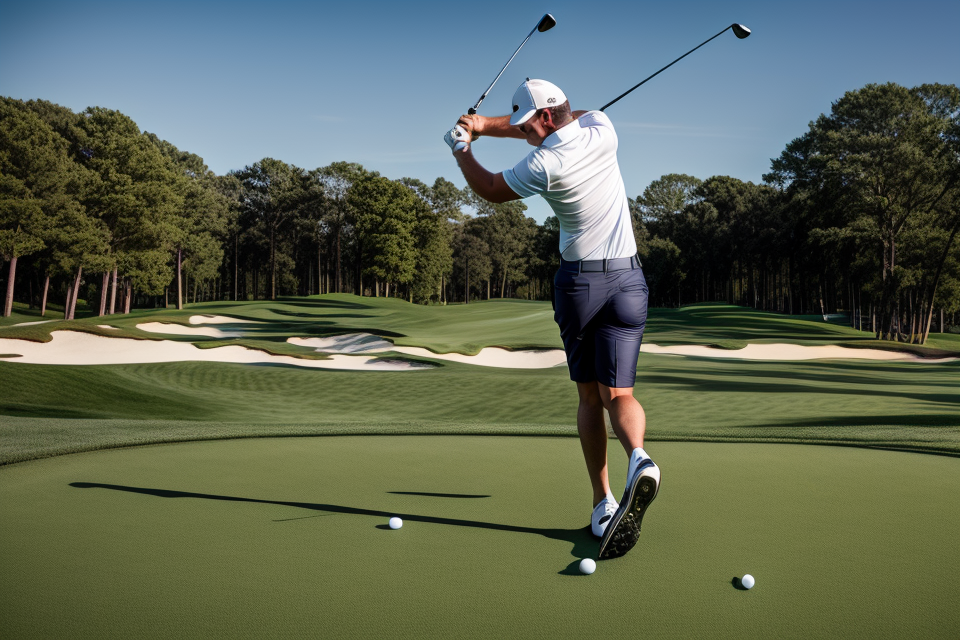Golf is a sport that requires precision, patience, and practice. The perfect golf swing is the holy grail of golfers, but achieving it can be a daunting task. It’s not just about hitting the ball straight and far, but also about controlling the ball’s trajectory and spin. Mastering the perfect golf swing takes time, effort, and dedication, but with the right techniques and practice, anyone can improve their game. In this article, we will explore some tips and techniques for achieving the perfect golf swing, including the correct grip, stance, and swing mechanics. So, whether you’re a beginner or an experienced golfer, read on to discover how to improve your game and hit that perfect shot.
Understanding the Fundamentals of a Good Golf Swing
The Importance of Posture and Stance
Maintaining proper posture and stance is crucial in achieving a good golf swing. A balanced and aligned body position allows for efficient power transfer and control throughout the swing. Here are some key aspects to consider when working on your posture and stance:
Standing with Your Feet Shoulder-Width Apart
Positioning your feet shoulder-width apart helps to establish a stable and balanced base. This alignment enables you to maintain proper weight distribution and balance throughout the swing, allowing you to control your body movements more effectively.
Keeping Your Weight on Your Back Foot
During the backswing, it’s essential to keep your weight on your back foot. This positioning allows you to utilize your lower body’s power and stability, while also enabling a smooth transition into the downswing. By shifting your weight to your back foot, you can maintain control and balance throughout the swing.
Bending Your Front Knee for Optimal Power
Bending your front knee during the swing is critical for generating power and control. A bent front knee provides a stable and flexible platform for the upper body to rotate around, allowing for efficient transfer of power from your lower body to your arms and hands. Maintaining a bent front knee also helps to maintain balance and control throughout the swing.
The Correct Grip on the Club
The correct grip on the club is essential for achieving a smooth and powerful golf swing. It may seem like a small detail, but the way you hold the club can have a significant impact on your performance. Here are some tips for getting the correct grip on the club:
- Holding the Club with Your Dominant Hand
The dominant hand is the one that you use for most everyday tasks, such as writing or holding a phone. It is usually the stronger hand. For right-handed golfers, the dominant hand is the right hand, and for left-handed golfers, it is the left hand. To find your dominant hand, try the following test:
- Hold a golf club with both hands, palms facing up.
- Close your eyes and rotate the club slowly in a full circle, clockwise for right-handed golfers and counterclockwise for left-handed golfers.
- When the club is pointing downwards, your dominant hand will be on top.
Once you have identified your dominant hand, make sure to place it closer to the club handle for a more secure grip.
- Placing Your Support Hand in the Right Position
The support hand is the hand that is not dominant and is placed on the other side of the club. It helps to control the club during the swing and provide stability. To place your support hand in the right position, follow these steps:
- Position your support hand slightly ahead of your dominant hand on the grip.
- Spread your fingers of your support hand so that they are separated by no more than two or three fingers.
- Lock your thumb in place by placing it against the underside of the grip.
This will help you maintain a strong grip on the club and prevent it from twisting during the swing.
- Maintaining a Light Grip Pressure
A light grip pressure is crucial for achieving a smooth and controlled golf swing. If you grip the club too tightly, you may feel tense and struggle to make consistent contact with the ball. On the other hand, if you grip the club too loosely, you may lose control of it during the swing. To maintain a light grip pressure, try the following tips:
- Relax your hands before starting your swing.
- Imagine that you are holding a small bird or a light object, such as a feather or a butterfly.
- Keep your hands relaxed and let the club do the work.
By following these tips, you can master the correct grip on the club and improve your golf swing.
The Swing Motion Explained
The golf swing is a complex motion that involves multiple parts of the body working together to generate power and accuracy. To master the perfect golf swing, it’s important to understand the fundamental elements of the swing motion.
Starting with Your Lower Body
The lower body plays a crucial role in the golf swing. The legs provide the foundation for the swing, and the hips initiate the movement. To start the swing, the legs should be shoulder-width apart, with the weight evenly distributed on both feet. As the swing begins, the hips should rotate, shifting the weight to the back foot. This rotation generates power and stability in the swing.
Transferring Power to Your Upper Body
Once the lower body has initiated the swing, the upper body should follow through. The arms should be extended from the shoulders, with the club held in the correct position. As the body rotates, the arms should also rotate, keeping the club in line with the body. The wrists should remain flexible, allowing for a smooth, powerful swing.
Accelerating the Clubhead through Impact
The most important part of the swing is impact, where the clubhead meets the ball. To accelerate the clubhead through impact, the arms and body should be in sync. The arms should extend fully, while the body continues to rotate. This generates speed and power, sending the ball flying down the fairway.
By understanding the fundamentals of the swing motion, golfers can develop a solid foundation for their swing. Focusing on these key elements will help improve power, accuracy, and consistency on the course.
Key Elements to Focus On
Alignment and Aim
Lining Up Your Body and Clubface
Proper alignment is crucial to achieving a powerful and accurate golf swing. To begin, stand behind the ball with your feet shoulder-width apart, aligning your shoulders, hips, and heels parallel to the target line. Your knees should be slightly bent, and your weight distributed evenly on both feet. Next, place the clubhead behind the ball, ensuring that the clubface points directly at the target. A common mistake is to close the clubface, causing a push or slice, so be sure to keep it square to the target throughout the swing.
Avoiding Common Mistakes
Many golfers make the mistake of tilting their body to the right during the backswing, causing an open clubface and a pull or hook shot. To prevent this, keep your shoulders level and your chest facing the target throughout the swing. Also, avoid lifting your head during the swing, as this can throw off your alignment and cause an inconsistent ball flight. Instead, keep your eyes focused on the ball and your chin tucked slightly to maintain proper posture.
The Importance of a Consistent Address Position
A consistent address position is essential for maintaining proper alignment and consistency in your shots. Stand with your feet, hips, and shoulders parallel to the target line, and make sure to keep your clubface square to the target. Practice your address position by taking several practice swings, paying close attention to your body and club alignment. Adopting a consistent address position will help you develop a more accurate and powerful golf swing, reducing the number of shots that miss the target.
The Swing Plane
Understanding the Golf Swing Plane
The golf swing plane refers to the imaginary plane that your club travels along during your swing. This plane is essential to maintain a consistent and powerful swing. It is determined by the angle of your shoulders and the position of your hands on the club.
Ensuring a Proper Release of the Club
A proper release of the club is crucial for a successful golf swing. This means that you should allow your arms to fully extend and release the clubhead at the end of your swing. This will help to ensure that the club travels along the correct plane and that you make solid contact with the ball.
The Role of Your Arms and Hands
Your arms and hands play a critical role in maintaining the correct swing plane. They should be positioned in such a way that they allow for a smooth and natural release of the club. This means that your hands should be placed in a neutral position, with your fingers relaxed and your wrists firm.
Balancing Power and Control
- Striking a Balance between Power and Accuracy
- Adjusting Your Swing for Different Shots
- Maintaining Control Throughout the Swing
Striking a Balance between Power and Accuracy
When it comes to hitting a golf ball, there is a delicate balance between power and accuracy. Golfers often struggle to find the right balance between these two key elements, which can impact the outcome of their shots.
Power is important because it allows golfers to hit the ball a long distance, which is crucial for reaching the green or getting out of difficult situations on the course. However, too much power can lead to accuracy issues, as the ball may veer off course or end up in an unintended location.
Accuracy, on the other hand, is essential for hitting the target and avoiding hazards or other obstacles on the course. However, lack of power can result in short shots that do not travel far enough to reach the desired location.
Therefore, finding the right balance between power and accuracy is critical for golfers who want to improve their game. It is important to understand that the ideal balance will vary depending on the situation, such as the distance of the shot and the wind conditions.
Adjusting Your Swing for Different Shots
One way to strike the right balance between power and accuracy is to adjust your swing for different shots. For example, when hitting a long shot, you may want to use a slower, more controlled swing to ensure accuracy. Conversely, when hitting a shorter shot, you may want to use a faster, more powerful swing to generate the distance needed to reach the target.
Golfers can also adjust their swing by making slight changes to their grip, stance, and posture. For example, a stronger grip can help generate more power, while a lighter grip can help promote a more accurate shot. Changing the position of your feet or the angle of your body can also impact the balance between power and accuracy.
Maintaining Control Throughout the Swing
Another important aspect of balancing power and accuracy is maintaining control throughout the swing. Golfers must be able to control their movements and keep their head down, eyes focused on the ball, and body in position. This requires a high level of concentration and focus, as well as a strong understanding of the mechanics of the swing.
One way to maintain control is to use a consistent pre-shot routine, which can help to calm the mind and establish a sense of rhythm. Golfers can also use visualization techniques to imagine the ideal shot and mentally rehearse the movements needed to execute it.
In addition, paying attention to the body can help golfers maintain control throughout the swing. This includes keeping the core engaged, using the legs and hips to generate power, and avoiding tension in the arms and hands. By focusing on these key elements, golfers can achieve a more balanced and controlled swing that produces accurate and powerful shots.
Tips for Improving Your Golf Swing
Practicing Good Body Mechanics
Maintaining good body mechanics is essential to achieving a smooth and powerful golf swing. Here are some tips to help you improve your body mechanics and enhance your golf game:
- Warming Up and Stretching Before Playing
Before hitting the golf course, it’s important to warm up and stretch your muscles to prevent injury and improve your flexibility. Spend a few minutes doing light cardio exercises, such as jogging or jumping jacks, to get your blood flowing and your muscles warm. Then, spend some time stretching your major muscle groups, including your shoulders, arms, and legs.
- Incorporating Drills to Improve Your Swing
Incorporating drills into your practice routine can help you develop good body mechanics and improve your swing. For example, you can practice your backswing by using a resistance band or a weighted club to increase the resistance and build strength in your back muscles. You can also practice your downswing by using a training aid, such as a swing plane trainer, to help you keep your hands ahead of the club and maintain a smooth, rhythmic swing.
- Building Muscle Memory
Building muscle memory is crucial to developing good body mechanics and a consistent swing. This means repeating the same swing motions over and over again until they become second nature. It’s important to focus on the feeling of the swing rather than the mechanics, as this will help you develop a natural, intuitive swing that becomes ingrained in your muscle memory.
Overall, practicing good body mechanics is essential to achieving a smooth and powerful golf swing. By warming up and stretching before playing, incorporating drills into your practice routine, and building muscle memory through repetition, you can improve your body mechanics and take your golf game to the next level.
Developing a Personalized Swing
One of the keys to mastering the perfect golf swing is developing a personalized swing that is tailored to your unique physical attributes and golfing style. Here are some tips for developing a personalized swing:
Analyzing Your Swing with Video Analysis Tools
Using video analysis tools is an effective way to analyze your swing and identify areas for improvement. These tools allow you to view your swing from multiple angles, including from above, from the side, and from behind. By analyzing your swing, you can identify any flaws or inconsistencies in your technique and make the necessary adjustments to improve your swing.
Seeking Professional Guidance from a Golf Instructor
Another important step in developing a personalized swing is seeking professional guidance from a golf instructor. A golf instructor can provide you with personalized feedback and advice on how to improve your swing. They can help you identify any flaws or inconsistencies in your technique and provide you with the tools and techniques to correct them.
Making Adjustments Based on Your Natural Swing
It’s also important to make adjustments to your swing based on your natural swing. Every golfer has a natural swing that is unique to them, and it’s important to work with this natural swing rather than against it. By making adjustments based on your natural swing, you can improve your swing and increase your accuracy and distance.
In conclusion, developing a personalized swing is crucial for mastering the perfect golf swing. By using video analysis tools, seeking professional guidance from a golf instructor, and making adjustments based on your natural swing, you can improve your swing and take your game to the next level.
Building Confidence and Trusting Your Swing
- Playing with Confidence
- Developing a Pre-Shot Routine
- Visualizing Success
- Positive Self-Talk
- Trusting Your Instincts
- Learning to Trust Your Natural Swing
- Paying Attention to Your Body’s Signals
- Letting Go of Bad Swings
- Maintaining a Positive Mindset
- Focusing on the Present Shot
- Avoiding Negative Thoughts
- Keeping the Big Picture in Mind
In order to master the perfect golf swing, it is essential to build confidence and trust in your ability to execute the shot. Many golfers struggle with this aspect of the game, as it can be difficult to shake off negative thoughts and doubts about one’s swing. However, by implementing the following tips, you can learn to play with confidence and trust your instincts on the course.
Playing with Confidence
Developing a Pre-Shot Routine
One of the most effective ways to build confidence on the course is to develop a pre-shot routine. This routine should include a series of physical and mental steps that you perform before each shot, such as taking a deep breath, visualizing the shot, and using positive self-talk. By sticking to this routine, you will create a sense of consistency and predictability in your approach to each shot, which can help you feel more confident and in control.
Visualizing Success
Another key aspect of playing with confidence is visualizing success. This means picturing yourself making the perfect shot, whether it’s a drive down the fairway or a putt that drops into the hole. By visualizing success, you can create a positive mental image that will help you feel more confident and focused when it’s time to take the shot.
Positive Self-Talk
Positive self-talk is another important aspect of playing with confidence. This means using positive affirmations and phrases to talk yourself through each shot, such as “I can do this” or “I trust my swing.” By using positive self-talk, you can help yourself stay focused and motivated, even when things aren’t going well on the course.
Trusting Your Instincts
Learning to Trust Your Natural Swing
In order to trust your instincts on the course, it is important to learn to trust your natural swing. This means relying on your body’s natural movements and instincts, rather than trying to force a particular swing that doesn’t feel natural. By trusting your natural swing, you can develop a more consistent and confident approach to each shot.
Paying Attention to Your Body’s Signals
Another key aspect of trusting your instincts is paying attention to your body’s signals. This means listening to your body and paying attention to any signals or sensations that may indicate that something is off with your swing. By paying attention to these signals, you can make adjustments and tweaks to your swing that will help you feel more confident and in control.
Letting Go of Bad Swings
Finally, in order to trust your instincts, it is important to learn to let go of bad swings. This means not dwelling on past mistakes or poor shots, and instead focusing on the present shot at hand. By letting go of bad swings, you can maintain a positive mindset and avoid getting bogged down by negative thoughts and feelings.
Maintaining a Positive Mindset
Focusing on the Present Shot
Maintaining a positive mindset is crucial for success on the golf course. This means focusing on the present shot, rather than worrying about past mistakes or future challenges. By focusing on the present shot, you can stay focused and motivated, and avoid getting bogged down by negative thoughts and feelings.
Avoiding Negative Thoughts
Another key aspect of maintaining a positive mindset is avoiding negative thoughts. This means avoiding self-criticism and negative self-talk, and instead focusing on positive affirmations and phrases. By avoiding negative thoughts, you can maintain a positive
Mental Game and Visualization Techniques
- Imagining Successful Shots
Visualization is a powerful tool that can help golfers improve their performance on the course. By imagining successful shots, golfers can train their minds to react positively to different situations, increasing their confidence and reducing anxiety. This technique involves mentally rehearsing the perfect shot, from start to finish, including the pre-shot routine, the swing itself, and the follow-through. By doing this regularly, golfers can improve their muscle memory and develop a more consistent swing. - Practicing Relaxation Techniques
Golf is a mentally and physically demanding sport, and it’s essential to maintain a relaxed state of mind and body throughout the swing. Practicing relaxation techniques, such as deep breathing, progressive muscle relaxation, and meditation, can help golfers stay focused and calm on the course. These techniques can also help reduce physical tension, improve posture, and increase flexibility, all of which can contribute to a more efficient and effective swing. - Developing a Pre-Shot Routine
Establishing a pre-shot routine can help golfers get into the right mindset and prepare themselves for each shot. This routine might include visualization, deep breathing, and a physical warm-up. By developing a consistent pre-shot routine, golfers can train their bodies and minds to perform optimally, increasing their chances of success on the course. It’s important to remember that every golfer is different, and what works for one person may not work for another. Experiment with different pre-shot routines to find what works best for you.
The Importance of Regular Practice
- Dedicating Time to Practice Your Swing
One of the most important aspects of improving your golf swing is dedicating time to practice regularly. It’s important to set aside time each day or week to focus on improving your technique and making adjustments as needed. This will help you develop muscle memory and make consistent improvements over time.
- Consistently Improving Your Technique
Regular practice also allows you to consistently work on improving your technique. By focusing on specific aspects of your swing, such as your grip or stance, you can make targeted improvements that will help you become a better golfer. It’s important to remember that golf is a sport that requires constant practice and improvement, so dedicating time to honing your skills is essential.
- Incorporating Swing Adjustments in Real-Time Play
In addition to regular practice, it’s important to incorporate swing adjustments in real-time play. This means making small adjustments to your technique during a round of golf, based on how your swing is feeling that day. This will help you make in-the-moment improvements and ensure that you’re constantly working to improve your game.
Overall, regular practice is key to mastering the perfect golf swing. By dedicating time to practicing your swing, consistently improving your technique, and incorporating swing adjustments in real-time play, you can become a better golfer and improve your overall game.
FAQs
1. What are the key elements of a perfect golf swing?
A perfect golf swing involves several key elements, including a proper grip, a correct stance, a smooth takeaway, a powerful backswing, a smooth transition, and a controlled finish. It’s important to keep your head down, your eyes focused on the ball, and your weight evenly distributed throughout the swing.
2. How should I grip the golf club?
A proper grip is crucial for a good golf swing. You should hold the club with your dominant hand at the bottom of the handle and your non-dominant hand at the top. Your fingers should be relaxed and your thumbs should be placed in a comfortable position. Your grip should be firm but not too tight, allowing for a natural movement of the club through the swing.
3. What is the correct stance for a golf swing?
The correct stance for a golf swing involves standing with your feet shoulder-width apart, with the balls of your feet facing forward. Your knees should be slightly bent, and your weight should be distributed evenly on both feet. Your torso should be tilted slightly forward, and your arms should be relaxed and loose. This stance allows for proper balance and control during the swing.
4. How should I start the golf swing?
To start the golf swing, you should take a smooth and controlled backswing, bringing the club back towards the ball in a semicircular motion. Your arms should be extended and your weight should shift slightly onto your back foot. At the top of the backswing, your hands should be above your head, and your eyes should be focused on the ball.
5. What is the best way to transition from the backswing to the downswing?
The transition from the backswing to the downswing is a critical moment in the golf swing. To make a smooth transition, you should use your legs and hips to shift your weight towards the target, allowing your arms to drop naturally towards the ball. Your hands should remain in contact with the club throughout the transition, and your eyes should stay focused on the ball.
6. How should I finish my golf swing?
To finish your golf swing, you should allow your arms to fully extend towards the ball, bringing the club head into impact. Your weight should be fully committed to the shot, and your body should remain in balance and control. After impact, you should allow the club to continue on its trajectory, and your hands should remain in a neutral position.
7. How can I improve my consistency in golf?
To improve your consistency in golf, you should focus on developing a consistent swing technique. This involves using the same pre-shot routine, taking a smooth and controlled backswing, transitioning smoothly to the downswing, and finishing with a controlled follow-through. Practice and repetition are key to developing a consistent swing, as well as focusing on proper mechanics and avoiding bad habits.





